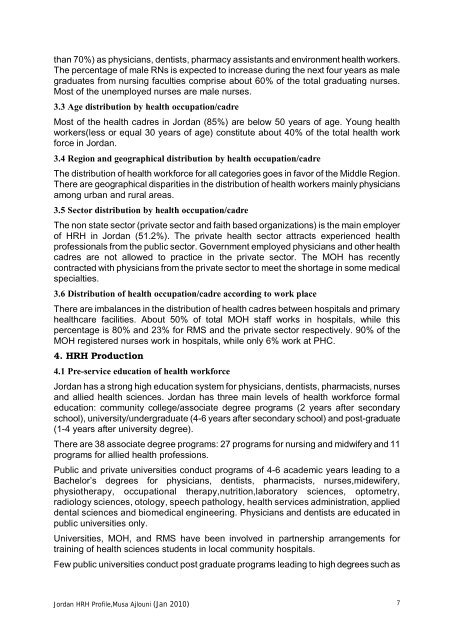Prepared by: Dr. Musa Ajlouni January, 2010 - World Health ...
Prepared by: Dr. Musa Ajlouni January, 2010 - World Health ...
Prepared by: Dr. Musa Ajlouni January, 2010 - World Health ...
Create successful ePaper yourself
Turn your PDF publications into a flip-book with our unique Google optimized e-Paper software.
than 70%) as physicians, dentists, pharmacy assistants and environment health workers.The percentage of male RNs is expected to increase during the next four years as malegraduates from nursing faculties comprise about 60% of the total graduating nurses.Most of the unemployed nurses are male nurses.3.3 Age distribution <strong>by</strong> health occupation/cadreMost of the health cadres in Jordan (85%) are below 50 years of age. Young healthworkers(less or equal 30 years of age) constitute about 40% of the total health workforce in Jordan.3.4 Region and geographical distribution <strong>by</strong> health occupation/cadreThe distribution of health workforce for all categories goes in favor of the Middle Region.There are geographical disparities in the distribution of health workers mainly physiciansamong urban and rural areas.3.5 Sector distribution <strong>by</strong> health occupation/cadreThe non state sector (private sector and faith based organizations) is the main employerof HRH in Jordan (51.2%). The private health sector attracts experienced healthprofessionals from the public sector. Government employed physicians and other healthcadres are not allowed to practice in the private sector. The MOH has recentlycontracted with physicians from the private sector to meet the shortage in some medicalspecialties.3.6 Distribution of health occupation/cadre according to work placeThere are imbalances in the distribution of health cadres between hospitals and primaryhealthcare facilities. About 50% of total MOH staff works in hospitals, while thispercentage is 80% and 23% for RMS and the private sector respectively. 90% of theMOH registered nurses work in hospitals, while only 6% work at PHC.4. HRH Production4.1 Pre-service education of health workforceJordan has a strong high education system for physicians, dentists, pharmacists, nursesand allied health sciences. Jordan has three main levels of health workforce formaleducation: community college/associate degree programs (2 years after secondaryschool), university/undergraduate (4-6 years after secondary school) and post-graduate(1-4 years after university degree).There are 38 associate degree programs: 27 programs for nursing and midwifery and 11programs for allied health professions.Public and private universities conduct programs of 4-6 academic years leading to aBachelor’s degrees for physicians, dentists, pharmacists, nurses,midewifery,physiotherapy, occupational therapy,nutrition,laboratory sciences, optometry,radiology sciences, otology, speech pathology, health services administration, applieddental sciences and biomedical engineering. Physicians and dentists are educated inpublic universities only.Universities, MOH, and RMS have been involved in partnership arrangements fortraining of health sciences students in local community hospitals.Few public universities conduct post graduate programs leading to high degrees such asJordan HRH Profile,<strong>Musa</strong> <strong>Ajlouni</strong> (Jan <strong>2010</strong>) 7

















